#Adam Bodorics
Text
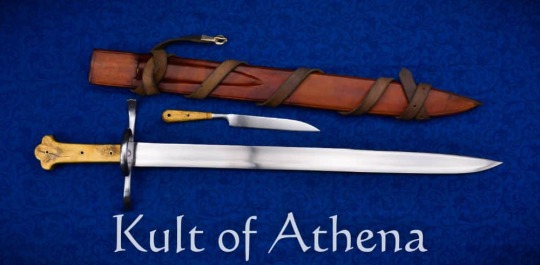


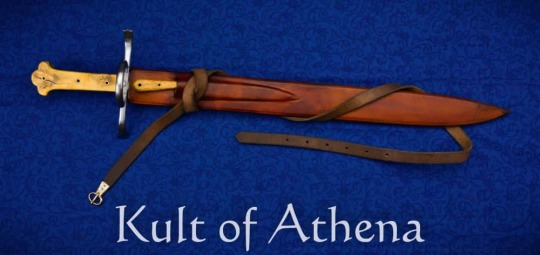
Ádám Bodorics – Beham Messer with Ring Hilt and Brass Frame Boxwood Grip
This Beham style Messer by specialist swordsmith Ádám Bodorics is a wonderfully agile sword in the hand that strikes with velocity and power – its wide and well-tempered blade bites deeply and its thin profile along the main cutting portion of the blade passes through a target with little drag and resistance – a truly fierce performer in a scrap of a melee! The thick ring at the hilt gives impressive protection to the entire hand from even notably larger weapons and the grip is a unique composite with the thick tang riveted and embedded between two halves of smoothly polished boxwood which is framed in strips of finely worked brass. The wood grip halves may look cracked, but they are actually created from a deliberate reconstruction of smaller pieces with strong and colored bonding filler in order to give the grip a unique theme and appearance that is perfectly apt to the troubled times of early 16th century Germany.
The sword is matched with scabbard of well-carved wood which is wrapped in linen for a binding to aid in durability which is then finished with overlaid tight leather with a compartment for a matching byknife which is included. Integrated and knotted to the scabbard is a thick sword belt with an adjustable buckle for wear. Below is Ádám’s own words on his unique creation offered here:
Messers take a huge variety of form and construction. This piece is based on a 1540 woodcut by Hans Sebald Beham with a subtle Memento Mori theme. In the 16th century, knifelike sidearms undergo several changes, one of them being the increasing regularity of hidden tangs. Illustrations from the period sometimes show rather complex grip shapes that would be complicated with a full-tang construction, but a hidden or a frame tang makes them much more trivial. Hans Sebald Beham often shows interesting grip shapes even in a bucolic setting, and it’s one of his woodcuts I based this piece on.
The straight and nimble blade is ground from 51crv4 (6150) high-carbon steel and is heat-treated to 50-52 HrC. It is optimized for cutting and slashing. It has plenty of distal taper and a wide fuller along it’s length. The cross has a gentle S-shape and a sidering instead of a Nagel. It is still affixed to the blade with a rivet o make sure it’s not mistaken for a sword or falchion or storta. The finials of the cross echo the trilobate design of the grip. The real tang of the blade reaches to about two-thirds of the grip. A thin steel plate was cut to the intended shape of the grip with a brass strip formed and soldered along it’s edges. The grip panels sit on the edges of the frame with the cavity between the panels and the tang filled with adhesive following the style of surviving frame-tang sidearms.
The byknife is hand-forged and ground from 80crv2 with integrated bolsters and a forge-welded mild steel tang. The grip panels are affixed by glue and tubular brass rivets of increasing diameter. The grip panels are boxwood, buxus sempervirens. These pieces were hand-picked to highlight the effects of the blight eradicating old growth, namely the aggressive checking from quick drying following rapid defoliation and the cloudy dark discolorations. There is evidence for boxwood’s continuous use for over two millennia, but as specimens large enough for larger carvings take an immense amount of time to grow, preventive culling or neglect of infected trees both make it near-impossible for this material to stay for long. To me, using these specific slabs was like erecting a gravestone, removing the need for any overt Memento Mori or Totentanz motifs.
The scabbard has a wooden core, linen wrapping and a vegetable tanned leather wrap with an integrated subsheath for the byknife. It is dyed a light brown and is undecorated to keep the attention on the hilt of the Messer. There is a belt threaded into two slits in the back of the sheath, crossing over to either side.
#Kult of Athena#KultOfAthena#New item Wednesday#Ádám Bodorics#Adam Bodorics#Beham Messer with Ring Hilt and Brass Frame Boxwood Grip#sword#swords#weapon#weapons#blade#blades#European Swords#European Weapons#Medieval Swords#Medieval Weapons#Renaissance Swords#Renaissance Weapons#messers#16th century
33 notes
·
View notes
Text
Bye-bye one of our fav series!
(Netflix's Sex Education)
Ini gif nya diambil dari ending season 3 soalnya relate ini ttg perpisahan hiks

Berhasil menamatkan 8 eps sex edu s4 dalam 4 hari wkwk lama ya? Uyuhan atuh nonton diatas jam 10 malem kdg dalam keadaan ngantuk bgt kami tuh saking pgn nobarnya berdua. Padahal bodor bgt ttp weh ai udah cape mah ketiduran juga haha.
Jadi gmn last seasonnya satisfying? Imho sih engga yah, walapun aku tetep amaze sama karakter2 development nya, juara sih beberapa org better bgt. Ya emang kan dari season awal jg sex edu mah selalu nyeritain banyak cerita, karakternya banyaaaak kek Game of Thrones. Belom lg tiap season ada karakter tambahan, sampe s4 pun begitu. Nah yg sangat disayangkan emg kalo di akhir tuh kaya pgn lebih deep ngga sih sama karakter2 lama, tp habis wkt kudu nyeritain karakter2 baru beserta problemnya. Ngga fokus di tokoh utama yg harusnya bisa lebih di gali. Scene2 yg selalu aku tunggu2 otis x eric aja jadinya sedikit bgt hiks. Mereka malah asik sama problemnya masing2 dan "dunia" nya masing2. Kenapa diantara keduanya itu dalam problem masing2 ngga saling terlibat sih?
Kalo percintaan otis x maeve mah udah pesimis dari awal dan udah ketebak dari awal sih. Otis si ngeselin nan problematik ternyata msh bergelut dgn traumanya, sex disorder sama trauma liat mamanya depresi wkt ayahnya ningalin. Jadi bisa ketebak hubungan percintaannya ngga lancar. Hiks!
Yang paling menghangatkan keluarga Adam, haaaa terharu inimah! Bapaknya yg kaku dan otoriter terlalu dingin sama istri dan anak, malah adam ngerasa dirinya gapernah "cukup" di mata bapaknya, sampe trauma jg. Akhirnya berpisah, tp dgn berpisah bapaknya jadi merasa tertampar, ternyata perilaku dia selama ini malah kehilangan anak dan istri. Selama hidup sendiri bapaknya merubah dirinya, belajar menjadi lebih baik sampe ikut kelas daring. Luar biasa bapaknya adam! Salute! Endingnya mereka bersatu. Seneng bgt liatnyaaaaa :')
Scene ibunya maeve meninggal jg bikin aku menitikkan air mata sih (pastinya inimah). Walaupun ibunya sering merugikan hidup maeve tp dia sangat sayang ibunya. Edan ngga sih, speech maeve wkt prosesi pemakaman ibunya sedih bgt!
Cerita viv x jackson bagus jg, hubungan platonik yg gausah sampe jadi romance deh, udah gitu aja ya gais. Viv nya jg pny pacar wlpn si gapenting pacarnya posesif, jd kaya hemm mending gosah diceritain lah.
OMG, Aimee! Akhirnya sembuh dari trauma pelecehan seksualnya, dia ini nih salah 1 karakter yg makin kesini makin lovely. Dia mengatasinya dgn journaling. Sungguh struggle dia melewatinya huhu. Tp yg ngga nyangka knp jadi saling suka sama Issac hahaha.
Jean, mamanya otis ngalamin postpartum depression. Ini kerasa bgt sih kacaunya dan ngerasain apalagi tanpa suami! Dan akupun ngerasain bgt yg dialami Jean, rumah berantakan, otak ngga sinkron, banyak lupa, mikirin A-Z. Jean butuh bantuan tp dia denial.. Belom diapun kudu kerja, gakebayang sih jadi single mom di umur yg udah mateng bgt. Nah karakter baru yaitu Jo adiknya Jean dateng deh.. Penolong diatuh tp ttp ada aja problematika sibling nya.
ERIC MY MAN! yaampun sampe kutambahin ini di edit lg wkwk. Tetep karakternya ekspresif bgt yg bikin kita berdua ngakak. Dia nemuin geng baru yg sefrekuensi sama dia sesama "pelangi" gitulah yaa dan geng itu berpengaruh di kampus. Inipun yg bikin hubungan eric x otis agak renggang, eric ngerasa otis ngga paham ttg dirinya yg lain. Yg mengharukan sih, eric tumbuh di kelg kristen tulen, dia mau di baptis tp saat pembaptisan dia speak up ttg dirinya yg pendosa dan jadi kaum pelangi. Didepan jemaat, ya kaget dong yaa.. Tp disitu eric lega bgt skaligus sedih. Singkat cerita di ending, eric memutuskan untuk jadi pendeta.. Pasti ini udah melalui pemikiran yg panjang bgt ya huhu.
Banyak bgt belajar pendalaman karakter yg aku pribadi pelajari di series itu, lebih berempati sama semua problem masing2 karakter, mencoba diliat dr berbagai sisi. Memandang secara objektif. Suka aja gitu~ makanya judul boleh agak keliatan mesum yah tp series ini lebih dari sekedar itu! Malah kayanya sex scenenya bisa di singkirin sih. Terlalu luvvv sama karakter2nya haaaa. Sampe tiap problem dan karakter developmentnya kita berdua suka bahas, terutama akusih yg selalu tertarik atau ya aku si chatter, tukang komen dan wewet tiap liat ke amazing-an karakter2nya yg memang ada aja di kehidupan sehari2.. Kecuali masalah perperlangian yaa itu msh tabu bagiku, ngerasain kebingungannya sama gendernya tapi liatnya malah makin bingung. Spesifikasinya terlalu banyaaak..
Suamiku @sagarmatha13 ngga terima udah tamat, dia mastiin lg ada tulisan "final season sex education" di netflixnya wkwk. Blio blg harusnya ada 1 season lg buat nyeritain si Cavendish nya, college nya itu. Karena transisi dari Moordale ke Cavendish kaya kagok bgt. Tapi kalo makin kacauain alur ceritanya mending dahlah stop disitu aja.. Walaupun ngga puas tp ya karena udah terlalu sayang sama karakter2nya jadi yasudahlah..
Once again, bye bye Sex Education.. Otis, Eric, Maeve, Ruby, Aimee, Adam and the gank. Thank you for entertaining us for the past 3 years!
(karena baru ngikutin series ini dari thn 2020 akhir)
4 notes
·
View notes
Text
Ilyen nevu emberek, hogy Náziró Tórepp - azt kepzelem, hogy bodor adam regenyekbol szuletnek erre a vilagra, kibujnak a lapok kozul.
5 notes
·
View notes
Text



Adam Bodorics Swordmaker | Facebook
With all three short-gripped Ruggers done, it's time for some comparisons. Even though the pommel-less version has a noticeably shorter grip, it's still only 23 grams lighter due to the quite different blade cross-section. The pommeled one is obviously the heaviest, even though the tang is tapered and fullered from both sides. The spine shot shows that while the very tip is practically the same 60° triangle, the rest of the blade is quite different.
Long-gripped/short-gripped/pommeled:
Oal: 725mm/670mm/665mm
Weight: 744g/721g/808g
Pob from top of bolsters: 92mm/119mm/95mm
0 notes
Text
Editorial Research & Inspiration



textured paper/effect. The image tends to be on one page of the spread. The illustration of the skeleton riding a bike caught my eye, as my dad rode bikes when he was younger. I also like how there is a margin on the second image, and how that image is hugged in near the page centre, whilst there is space on the left side.
Retrieved from https://www.behance.net/gallery/97736273/STUSSY-ISSUE-08

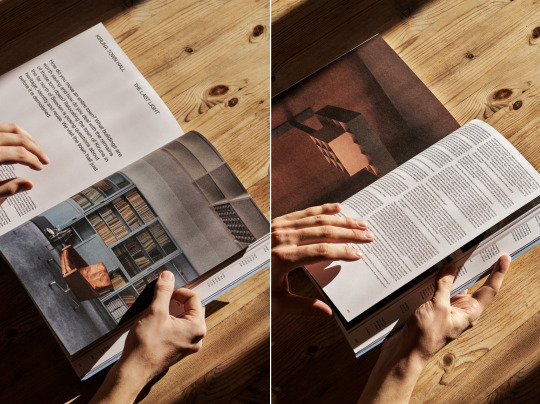
looking at the different layouts, and how the grid system works as a whole. the one column is something that appeals to me, but ten also splitting up into you columns. I am drawn to the aesthetic of having the supporting text with a very narrow margin and wider gutter. This is something that I haven’t done before. looking at it from a visual perspective, most pages are filled with a whole image. I want to think about the scale of the image, it may suit to have it enlarged or to have it smaller and maybe even centre.
Retrieved from https://www.behance.net/gallery/117816369/THE-NEW-ERA-MAGAZINE-ISSUE-02
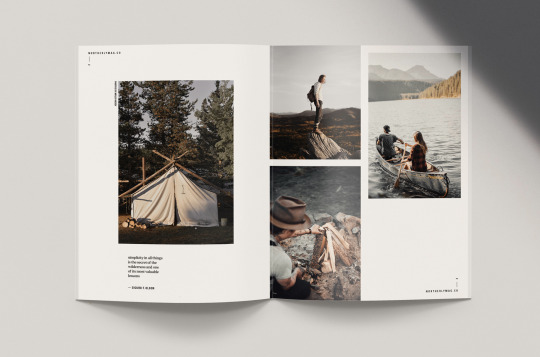

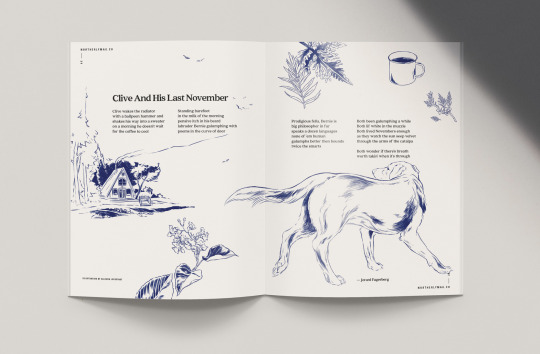
Layering of the different elements of the editorial is interesting and could potentially be something to think about. The one long column again reappears. The title of the book and the book numbers are. on each corner of the spread. The hierarchy in this is that the title and illustrations or imager is the dominant, following with the smaller contexts.
Retrieved from https://www.behance.net/gallery/90943927/Northerly-Magazine-Fall-2018



Interesting cover and back cover. Using a logo at the bottom and having the title of the book enlarged running over the spine and onto the back and front cover. Unusual design which I haven’t come across before. The smaller inner pages are very cool. Could be something to consider to push the brief?
Retrieved from https://www.behance.net/gallery/114805431/EQUALIZER2020-TOUR\

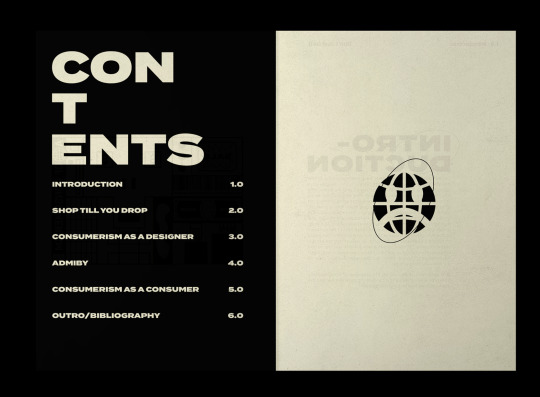

Im liking the colours, and the outlined drawings. I think this is very simple but effective. The placement of the title and the title of the book up along the top is effective. Again wider gutter and thinner margins. Having the page number, just one of the left hand side. The pages seem slightly see through which is quite cool.
Retrieved from https://www.behance.net/gallery/114036127/Dont-Just-Do-It-Zine



Simple and minimalistic design. It feels high quality. the imagery is quite organic, with rugged lines and texture. The design is centred with the imagery being in the middle of the page. The text is in the corner and the imagery is on the opposite corner which is effective.
Retrieved from https://www.behance.net/gallery/120991879/Bodor-Adam-Sinistra-Koerzet


I found it interesting how the pull quotes are in bold and are out of alignment with the rest of the paragraph. This provides emphasis and also depicts a distort like feeling.
Retrieved from https://www.behance.net/gallery/124024869/Stuessy-No-19-%28editorial%29
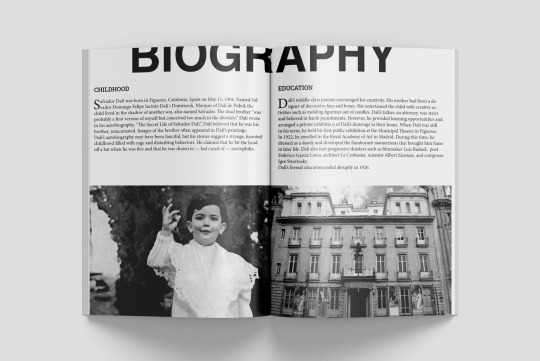


Lots of negative space, two column grid, working cohesively with one another. I like how the titles are placed centred and run across the two pages. Imagery is black and white, feels like an early generation. Something to consider is the biography of the person or background info. This editorial focuses on this one person and tells a story through visual language.
Retrieved from https://www.behance.net/gallery/120370701/Salvador-Dali-Editorial-design



Interesting cover design, pop colours with bland background suggests an intentional contrast. What drew me in was the typography and how it moves across the page and out of the photo.
Retrieved from https://www.behance.net/gallery/116527151/NME-in-print
1 note
·
View note
Text
César Urbano Taylor recomienda: Cesar Garcia Urbano Taylor: A los españoles les gusta la bici eléctrica
La firma Shimano publica los resultados de una gran encuesta europea sobre la voluntad de uso de las eBikes.
Un 39% de los españoles estarían dispuestos a usar una bicicleta eléctrica para ir a trabajar. Esta es la principal conclusión que se puede extraer de una encuesta que la empresa Shimano ha realizó vía online a principios de este año. Según los resultados de la encuesta, España se situaría en segunda posición en el deseo de uso de la eBike, justo por detrás de Holanda (47%) y por delante de países como Italia (33%), Bélgica (31%) y Noruega (27%).
El estudio recoge las respuestas de 12.000 personas, entre el 20 de enero y el 13 de febrero. Entre los principales motivos para pasarse a la bici eléctrica se citan, por este orden, mantenerse en forma, proteger el medio ambiente y ahorro de dinero. Eso sí, también se contemplan los principales inconvenientes para pedalear: el mal tiempo, precio de las eBikes y llegar sudado al trabajo.
Para el responsables de la Federación Europea de Ciclistas, Adam Bodor, estos resultados son una buena noticia que “confirma que hay un gran potencial para las bicis eléctricas, especial en combinación con la creación de carriles-bici que cubran distancias más largas y permitan sustitutiva viajes en coche”.
España es uno de los mercados en los que más ha crecido la venta de la bici eléctrica en los últimos dos años. Sin embargo, nuestro país sigue viendo la bicicleta como un bien destinado al uso deportivo, en el que se han focalizado ese gran crecimiento, especialmente para el ciclismo de montaña. El gran reto, para los responsables de las asociaciones ciclistas y la industria, es trasladar ese auge por la eBike al uso cotidiano, como vehículo de transporte sostenible, que permita hacer más saludables y amables las ciudades. En este sentido, algunas de las ciudades españolas, como es el caso de Barcelona y Madrid, han implantado ya bicis eléctricas en su servicio de bicis de alquiler.
Ver fuente
Ver Fuente
0 notes
Text
Chamber Project St. Louis Announces 2017/18 Season - “Celebrating St. Louis”
Chamber Project St. Louis Announces 2017/18 Season – “Celebrating St. Louis”
Season Ten begins 9/8 with a FREE concert at the Missouri History Museum and includes three world premieres with Adam Maness, Zachary Cairns, and Katherine Bodor
(more…)
View On WordPress
0 notes
Text


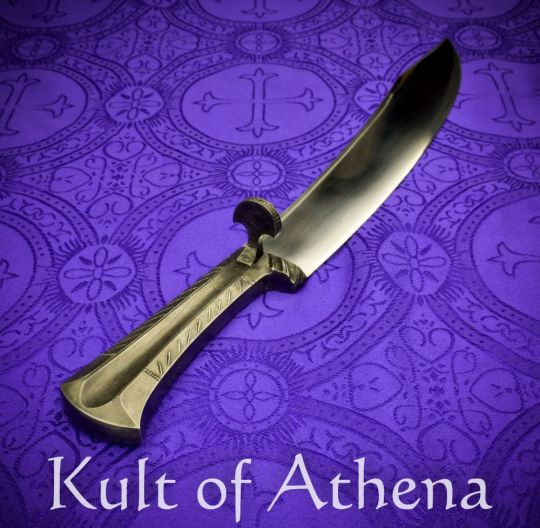

Ádám Bodorics – All Steel Bauernwehr and Scabbard
This stylistically unique and custom crafted Bauerwehr bt Ádám Bodorics has a sharpened and well tempered blade which is solidly constructed and matched to a hilt of steel. The dagger comes with a scabbard of wood hich is sheathed in steel and completed with a steel hanging belt loop. The dagger feels quite capable and authoritative in the hand and its blade has a thick spine to ensure it has excellent durability. Below are Ádám’s own thoughts on his custom creation:
The Bauernwehr is the dagger-sized relative of the Messer, and it also exhibits noticeable variation. This specific piece has no historical analogue as far as I know, rather it’s an interpretation of a trend present on a variety of different sidearms from the period. All-metal and full-steel sidearms appear with some regularity from the end of the 15th century.
We see it on an early rapier, a glorious Kriegsmesser, several quillon daggers, stortas – so to me it made sense to create a Bauernwehr in this style. The blade is hand-forged and ground from 80crv2 and is heat-treated to 54-56 HrC. It has a minimal amount of distal taper to avoid making it too hilt-heavy. The false edge is also fully sharpened. There is a narrow and shallow fuller on both sides along the spine. The tang extends into the hilt only partially and is heavily tapered. The entire hilt is forged, ground, filed and chiseled from a single piece of mild steel. The “bolster” and “pommel” areas are marked out with pairs of filed lines, further decorated with chiseled lines. The fuller extends from the “bolsters” all the way through the “pommel”, with the sides further emphasized with a filed border. The “grip” area is lightly decorated with chiseled diagonals, emulating the puff&slash fashion slowly coming into vogue by the end of the century. It is secured to the blade by five steel rivets peened and filed down. Three rivets are along the tang, one at the edge end of the “bolsters” and one at the spine end of them.
The Nagel is also embellished by filework and chiseling, and is peened on the other side, with the peen filed down very close to the fuller of the grip. The entire hilt was cold-blued with a light touch bringing out the high spots, highlighting the details. The scabbard is based on a variety of dagger scabbards, redesigned to fit the curved blade. It has a wooden core and a mild steel cover fabricated from multiple pieces. It emulates the puff and slash fashion of the 16thcentury and has a relatively simple and subdued finial. The suspension is a chain made up of strips and rings of steel, based on a period original, terminating in a steel belt loop. It is also cold-blued and highlighted to match the hilt.
#Kult of Athena#KultOfAthena#New item Wednesday#Ádám Bodorics#Adam Bodorics#All Steel Bauernwehr and Scabbard#Knives & Daggers#Knife#knives#Medieval Knives & Daggers#Renaissance Knives & Daggers#weapon#weapons#Medieval Weapons#Renaissance Weapons#Bauernwehr#80crv2 High Carbon Steel#Battle Ready
13 notes
·
View notes
Text




Ádám Bodorics – Thrust and Cut Messer
Stiff bladed and well-tempered, this custom-crafted Messer from specialist swordmaker Ádám Bodorics thrusts and punctures with particularly vicious ability and it also delivers slicing cuts with decisive authority, a long false edge that runs almost half the length of the blade spine both allows for a secondary edge to be employed, as well as thinning the blade profile so that it can deftly slice through a target with minimized drag. Inspired by an original historic design, this Messer is swift in the single hand and its elongated grip allows for the use of secondary hand for greater power and leverage as the situation warrants it. The spike-hilt crossguard and nagel are crafted from steel and the thick blade tang is stoutly riveted between two halves of ebony wood. The nagel is securely peened on the reverse side of the crossguard.
The sword is matched with a finely crafted wood-core scabbard which is hand stitched with a finishing layer of tool-embossed black leather. It includes housing for the included byknife and is finished with a thick leather sword belt for wear. A fantastic and very capable Messer for someone who wants one that will stand out from the pack! Below are Adam’s own words about it:
Messers come in a huge variety of shapes and forms. This specific piece is pretty far from what most people think “typical” Messers to be with it’s thrust-optimized, almost swordlike blade. The piece is loosely based on an original in Glasgow which was brought to my attention by James G. Elmslie. As full documentation isn’t available yet, I just took the concept and some features from the two photos I have access to, making it very much not a copy.
The blade is hand-forged and ground from 51crv4 (6150) high-carbon steel, heat-treated to 50-52 HrC. It has a pentagonal cross-section for about two-thirds of it’s length, with the back being unsharpened. This
seamlessly transforms into a stiff diamond for the final third of the blade. The cross and Nagel are both hand-forged from mild steel. The cross slides down along the blade, affixed in place by the Nagel. The width of the cross in proportion to grip length is based on the original, and so is the approximate shape, making it a very angular and pointy thing.The original lost it’s grip, but the quillon block clearly shows the cross-section, so I went with that. The grip slabs are Gabon ebony with brass spacers. It is secured by black epoxy, a much more stable emulation for cutler’s pitch, and sterling silver rivets properly peened to keep it a completely black and white set.
The byknife is forged and ground from 80crv2, heat-treated to 54-56 HrC. The bolsters and all the rivetsare also made from sterling silver. The grip shape emulates the main piece, and the material is from the
same plank of ebony. The scabbard with it’s integrated byknife subsheath has a wooden core, a linen wrap and a leather cover. The leather is decorated with floral motifs loosely based on a period illustration. The back of the scabbard has two vertical slits for the silver-buckled belt which crosses over on the front.
#Kult of Athena#KultOfAthena#New item Wednesday#Ádám Bodorics#Adam Bodorics#Thrust and Cut Messer#Messer#sword#swords#weapon#weapons#blade#blades#European Swords#European Weapons#Medieval Swords#Medieval Weapons#Renaissance Swords#Renaissance Weapons#6150 High Carbon Steel#Battle Ready
13 notes
·
View notes
Text

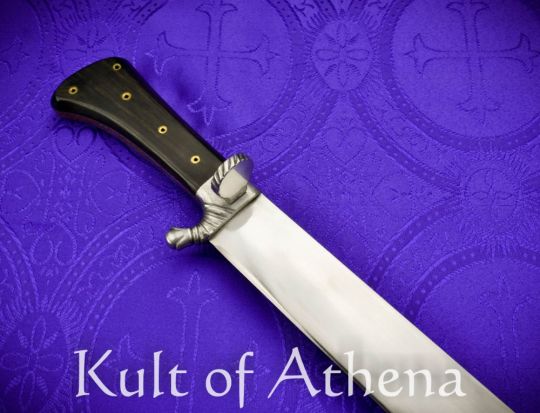
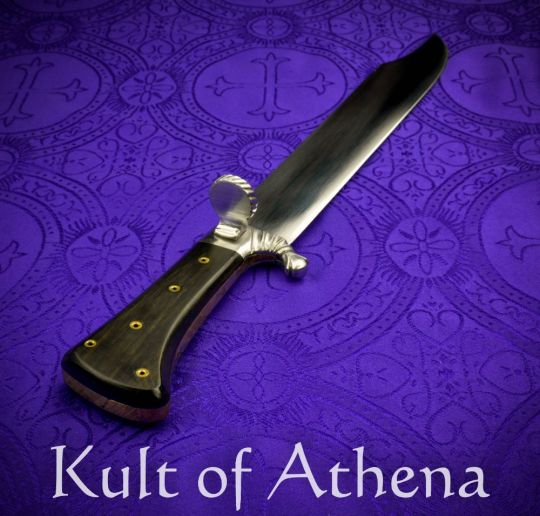

Ádám Bodorics – Brass and Ebony Bauernwehr
This custom crafted Bauernwehr by specialist bladesmith Ádám Bodorics is a fine way to complete your landsknecht kit with a unique and fetching blade suitable for war and camp. The tough and rigid blade of well tempered steel is sharpened and mirror polished – the blade also has a very thick blade spine to ensure it has outstanding durability. The bolster and riveted nagel are steel and the grip is a composite with a hidden and riveted blade tang surmounted by grip scales of ebony and completed with chiseseled brass framing strips. Included is a wooden scabbard which is bound in leather and throrougly embellished with brass. Included is a utility byknife and pricker which neatly fit into integrated slotted compartments on the scabbard. Below are Ádám’s own thoughts on his custom creation:
Bauernwehrs, the dagger-sized relatives of Messers, took a variety of forms utilizing several different construction methods. Details on this set place it firmly into the middle of the 16th century in style.
The blades are forged and ground from 80crv2 high-carbon steel, heat-treated to 54-56 HrC. A shared feature is the heavily tapered tang surrounded by a chiseled brass strap, which detail is taken from an unpublished original studied in a private session. The Gabon ebony grip slabs sit on the frame, with the gap between the slabs and the tang filled with adhesive. This method is taken from surviving frame-hilt sidearms of this and later eras – as it seems universal to frame-hilt pieces from the areas of modern-day Poland, Turkey and Iran, I don’t believe more Western pieces would be constructed differently. All grips
are secured by tubular rivets which are peened, as I have no trust in simple pins.
The principal blade has a short false edge and simple filework on the spine. The bolsters are decorated with filework with the vestigial guard taking the shape of a stylized flower. The Nagel is also fileworked with diagonal lines, matching the scabbard’s finial. It is peened on the other side of the bolsters. The byknife has a simple flat triangular cross-section and brass bolsters with simple geometric decor on it. Normally I find it easier to rivet on the bolsters first and grip slabs after, but thorough study of a surviving frame-hilt knife showed tool marks clearly showing a different order of operations, so this time
it was grip slabs before bolsters.
The pricker is also heat-treated, making it somewhat usable for honing, but my experience and the number of un-heat-treated originals strongly imply that they are much less specialized tools. In a pre-modern setting, without all the comforts we are used to, having a pointy, stiff but non-sharp piece can have a variety of uses from simply punching holes to undoing stubborn knots in arming points. The sheath has goat parchment linings for each blade, which are covered and held together by vegetable tanned leather dyed black by iron-acetate. For bonding the pieces and layers I only used hide glue. The entire piece is reinforced and decorated with a hand-wrought brass sheath frame. While these and similar frames are somewhat rare in reproductions, there are multiple surviving originals ranging from even simpler ones in iron all the way to the sculpted and gilt ones on Holbein daggers. A rather eye- catching detail is the strap around the mouth of the bypiece subsheaths, emulating the puff and slash style of period clothing. While most of the originals I’m aware of in this style are on daggers, there’s plenty of evidence for it’s use on Messers and adjacent sidearms. For suspension, there’s a pair of brass tubes on the back for a leather thong for vertical carry on a belt. The frame is held in place by friction provided by the tight fit around the sheath.
#Kult of Athena#KultOfAthena#New item Wednesday#Ádám Bodorics#Adam Bodorics#Brass and Ebony Bauernwehr#weapon#weapons#blade#blades#Knives & Daggers#Medieval Knives & Daggers#Renaissance Knives & Daggers#Medieval Weapons#Renaissance Weapons#Messer#80crv2 High Carbon Steel#Battle Ready
8 notes
·
View notes
Text
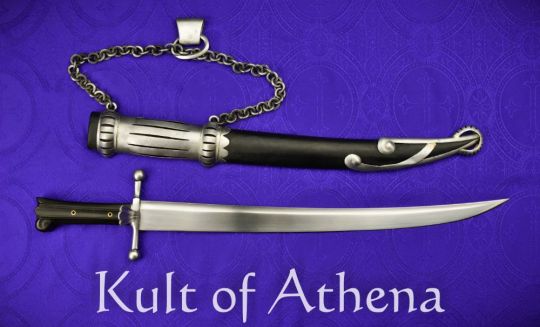


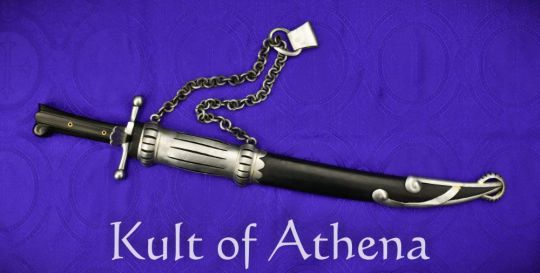
Ádám Bodorics – Ebony Grip Hidden Tang Messer
This beautifully balanced and custom-crafted Messer by specialist swordsmith Ádám Bodorics feels like a natural extension of the hand and its well-tempered and sharp blade slices quickly, cleanly and decisively. The guard and riveted nagel are of steel and the grip is finely carved from smoothly polished fine ebony wood which is directly riveted to the blade tang. The sword is matched with a wood-core scabbard which is lavishly embellished with steel fittings in a landsknecht inspired style. A hanging chain and belt loops allows for it to be worn on the belt. Below are Ádám’s own thoughts on his custom creation:
The large variance in Messers and related sidearms make them a great medium for experimentation and theoretical designs. With this ebony-hilted piece, I intended to create something completely new based on sources mainly from between 1520-1540. In the 16th century, knifelike sidearms undergo several changes, one of them being the increasing regularity of hidden tangs. Illustrations from the period sometimes show rather complex grip shapes that would be complicated with a full-tang construction, but a hidden or a frame tang makes them much more trivial. In this case, I went for a hidden tang and a one-piece ebony grip.
The light, curved blade is ground from 51crv4 high-carbon steel and is heat-treated to 50-52 HrC. While the shape favors cutting and slicing, the tip is subtly reinforced. The spine visibly thickens in the last few milimeters, and the edge angle gets a bit more obtuse. I spotted this detail first on a heavily curved Kriegsmesser from the Kunsthistorisches Museum, but I noticed it elsewhere as well since. The proper tang is relatively short, not an uncommon detail on 16th century specimens.
The short cross with it’s finials is based on a pair of illustrations by Monogramist HD from 1545, and so is the approximate shape of the Nagel. The cross is slid down along the blade and is affixed in place by
the triple-fullered, hand-forged and filed Nagel. The most striking part of the Messer is the grip carved and filed from a single piece of Gabon ebony including a shape following pommel type CC2. This is the most theoretical part as well. If we define CC2 pommels as having a complex bottom profile (as opposed to the simple curve of type CC1), then there are plenty of illustrations showing non-metal grip ends matching the type, from Dürer, Beham, etc. If we limit the definition to the somewhat architectural type done by Sumersperger and the makers of several early 16th century pieces, then we even have an existing piece where the shape is part of the organic grip, all the way back in the late 13th century (NDK-1123-2, shown in Cahiers LandArc 2017 N24, pg2). The swirl of the “beak” is present on several sources as well, from a very basic version by Hans Sebald Beham’s “Peasant at the marketplace” through a richly decorated swirl painted by Lucas Cranach the Elder in “Judith with the head of Holofernes” all the way to the dizzying all-metal Kriegsmesser by Melchior Diefstetter in Vienna. I aimed at a relatively simple shape that would be still above the one on
the Beham woodcut.
The scabbard is based on the already-mentioned illustrations by Monogramist HD. It has a wooden core, a black leather cover and several steel fittings. The largest of said fittings emulate the puff&slash fashion of the time. This detail is found on surviving scabbards of the period, not just in art. The suspension is by a length of handmade mild steel chain and a metal belt loop as in the inspiring illustration. Monogramist HD shows both Messers in a right-side, edge-up carry position – as this is without parallel in the period, I set the scabbard up for a more conventional, left-side, edge-down carry position.
#Kult of Athena#KultOfAthena#New item Wednesday#Ádám Bodorics#Adam Bodorics#Ebony Grip Hidden Tang Messer#Messers#sword#swords#weapon#weapons#blade#blades#European Swords#European Weapons#Medieval Swords#Medieval Weapons#Renaissance Swords#renaissance Weapons#16th century#6150 High Carbon Steel#Battle ready
8 notes
·
View notes
Text
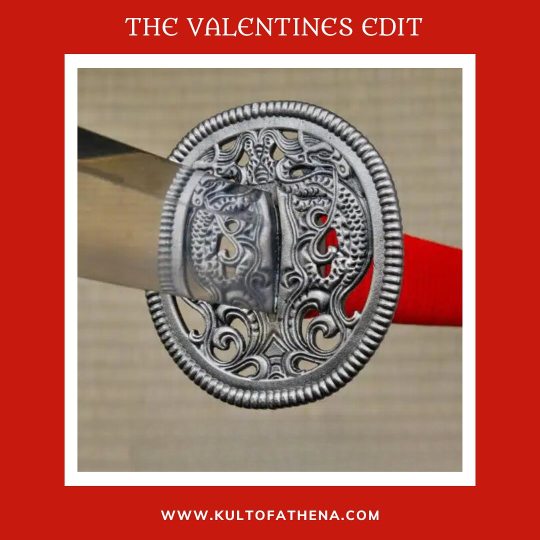

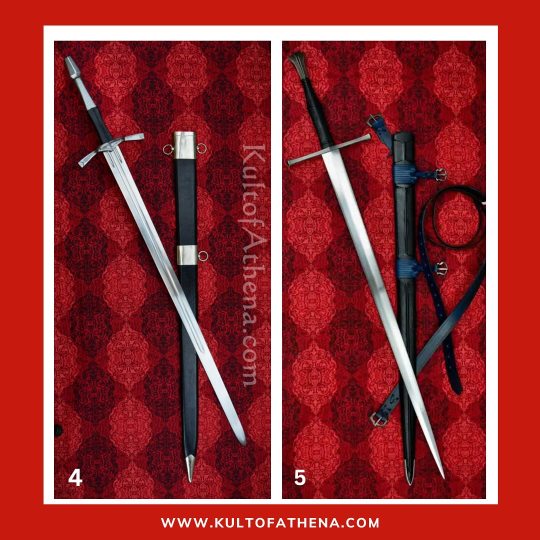
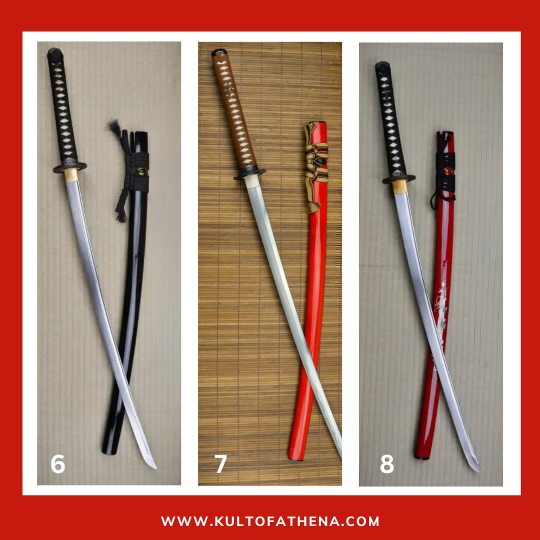

❤️ The Valentines Edit ❤️
What would you want someone to pick for you?
1. BKS Leaf Blade Greatsword
2. Hanwei Hand and a Half Sword
3. Cold Steel La Fontaine Sword of War
4. Deepeeka 15th Century Ring-Hilt Longsword
5. Vision -The Strasbourg Longsword
6. LK Chen – Tatsu Katana
7. Dragon King – Tenka Fubu Katana
8. Musha – Red Dragon Katana
9. Adam Bodorics – Landsknecht 16th Century All-Steel Dagger
10. LK Chen – Tizona – 17th Century Spanish Cup-Hilt Rapier
#Kult of Athena#KultOfAthena#Valentine's Day#Baltimore Knife & Sword#Hanwei#Cold Steel#Deepeeka#Vision#LK Chen#Dragon King#Musha#Adam Bodorics#17th Century Spanish Cup-Hilt Rapier#Landsknecht 16th Century All-Steel Dagger#Red Dragon Katana#Tenka Fubu Katana#Tatsu Katana#The Strasbourg Longsword#15th Century Ring-Hilt Longsword#La Fontaine Sword of War#Hand and a Half Sword#Leaf Blade Greatsword#Battle Ready#Stage Combat#Sport Combat#sword#swords#weapon#weapons
2 notes
·
View notes
Text

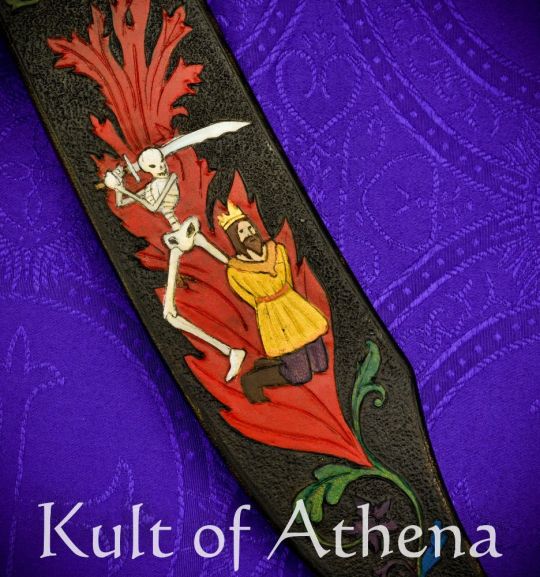

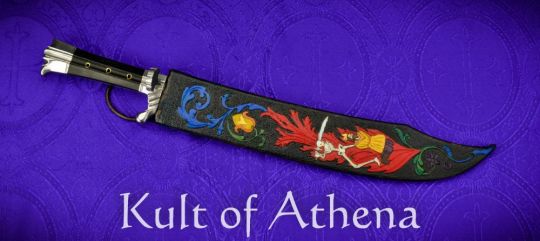
Ádám Bodorics – Ebony Grip Bauernwehr with Totentanz Motif Scabbard
This custom crafted Bauernwehr by specialist bladesmith Ádám Bodorics matches an elegant, but powerful-striking Bauernwehr fighting dagger with a marvelously crafted scabbard with hand tooled and handpainted Totentanz motif. The thick-spined dagger is quite robust and rigid and is well-tempered and sharpened and comes with plenty of mass to power it decisively through its target and a clipped tip point gives it impressive puncture ability as well. The grip has a bolster, pommel and nagel of steel and two grip halves of finely carved and smoothed ebony which are riveted directly to the thick blade tang which is tapered for improved overall balance. The included wood-core scabbard is bound in wood and meticulously hand tooled to create a complete package that is a fine custom piece to complete your Landsknecht kit. Below are Ádám’s own thoughts on his custom creation:
Bauernwehrs, the dagger-sized relatives of Messers, took a variety of forms utilizing several different construction methods. This piece would fit in best at the turning point of the 15th and 16th centuries. The slightly curved blade is forged and ground from 80crv2 high-carbon steel, heat-treated to 54-56 HrC. There’s a shallow and relatively narrow fuller ground into both sides along the spine, terminating under the bolsters as is customary in the period. There’s just enough distal taper in the blade to make it lively without allowing the pommel to make it too hilt-heavy. The bolsters are decorated with filework. The strong change in cross-section between the “guard” and the body of the bolsters is a common feature on originals and can be seen on protokatzbalgers, Messers and Bauernwehrs alike.
The edge of the Nagel is filed in a pattern that I came up with myself. The idea was to create something unprecedented to my current knowledge, yet make it fit the overall aesthetics. The pommel is affixed by silver solder onto the heavily tapering tang. The shape is categorized as type CC2 in the Elmslie-typology and is defined by the bottom being made up of multiple curves and lines as opposed to CC1 pommels, where it’s a single curve. Originals of this type of pommel exhibit huge variance from quite simple and rounded forms all the way to the highly sculptural works of Hans Sumersperger. This version falls in the middle of the spectrum.
The grip panels are Gabon ebony and are affixed by gluing and tubular rivets peened in the fuller running along the entire hilt. The scabbard has a wooden core and a luxuriously decorated leather wrap. The Totentanz motif is my own design, and so are the vines and flowers but all take inspiration from illustration and codex marginalia from the 15th-16th centuries. There are raised leather channels in the back for a leather thong for vertical carry on a belt.
#Kult of Athena#KultOfAthena#New item Wednesday#Ádám Bodorics#Adam Bodorics#Ebony Grip Bauernwehr with Totentanz Motif Scabbard#Ebony Grip Bauernwehr#Bauernwehr#Knives & Daggers#Medieval Knives & Dagger#Renaissance Knives & Daggers#Medieval Weapons#Renaissance Weapons#Totentanz motif#15th century#16th century#80crv2 High Carbon Steel#Battle Ready
6 notes
·
View notes
Text
instagram
✨ NEW and LIMITED✨
(only 3 available )
🗡️ In the 16th century, a unique style of daggers called Landsknechtdolchen, or "Landsknecht daggers," emerged.
🗡️These daggers combined elements from rondels, quillon daggers, and ballocks, but are distinct in their own right.
🗡️This specific model's hilt is based on an original in a private collection, made from six hand-formed pieces soldered together.
🗡️ The dagger offers a secure grip, locking the user's fist between the guard and pommel.
🗡️ The blade is optimized for thrusting, with a narrow profile, obtuse angles, and a reinforced tip for targeting mail-covered opponents.
🗡️ The scabbard emulates the fashion of the time, and simpler versions can be seen in woodcuts from the period.
Order now
#Kult of Athena#KultOfAthena#Adam Bodorics#Landsknecht 16th Century All-Steel Dagger#Knives & Daggers#Medieval Knives & Daggers#Renaissance Knives & Daggers#Landsknecht Emporium#16th century#mercenary#Landsknecht Mercenary#6150 High Carbon Steel#Battle Ready#Instagram#videos
2 notes
·
View notes
Text

Below are Adam’s own words about this custom made one of a kind Thrust and Cut Messer:
Messers come in a huge variety of shapes and forms. This specific piece is pretty far from what most people think “typical” Messers to be with it’s thrust-optimized, almost swordlike blade. The piece is loosely based on an original in Glasgow which was brought to my attention by James G. Elmslie. As full documentation isn’t available yet, I just took the concept and some features from the two photos I have access to, making it very much not a copy.
The blade is hand-forged and ground from 51crv4 (6150) high-carbon steel, heat-treated to 50-52 HrC. It has a pentagonal cross-section for about two-thirds of it’s length, with the back being unsharpened. This
seamlessly transforms into a stiff diamond for the final third of the blade. The cross and Nagel are both hand-forged from mild steel. The cross slides down along the blade, affixed in place by the Nagel. The width of the cross in proportion to grip length is based on the original, and so is the approximate shape, making it a very angular and pointy thing.The original lost it’s grip, but the quillon block clearly shows the cross-section, so I went with that. The grip slabs are Gabon ebony with brass spacers. It is secured by black epoxy, a much more stable emulation for cutler’s pitch, and sterling silver rivets properly peened to keep it a completely black and white set.
The byknife is forged and ground from 80crv2, heat-treated to 54-56 HrC. The bolsters and all the rivetsare also made from sterling silver. The grip shape emulates the main piece, and the material is from the
same plank of ebony. The scabbard with it’s integrated byknife subsheath has a wooden core, a linen wrap and a leather cover. The leather is decorated with floral motifs loosely based on a period illustration. The back of the scabbard has two vertical slits for the silver-buckled belt which crosses over on the front.
#Kult of Athena#KultOfAthena#WorldOfKOA#Ádám Bodorics#Adam Bodorics#Thrust and Cut Messer#Messer#sword#swords#weapon#weapons#blade#blades#European Swords#European Weapons#Medieval Swords#Medieval Weapons#Renaissance Swords#Renaissance Weapons#6150 High Carbon Steel#Battle Ready
3 notes
·
View notes